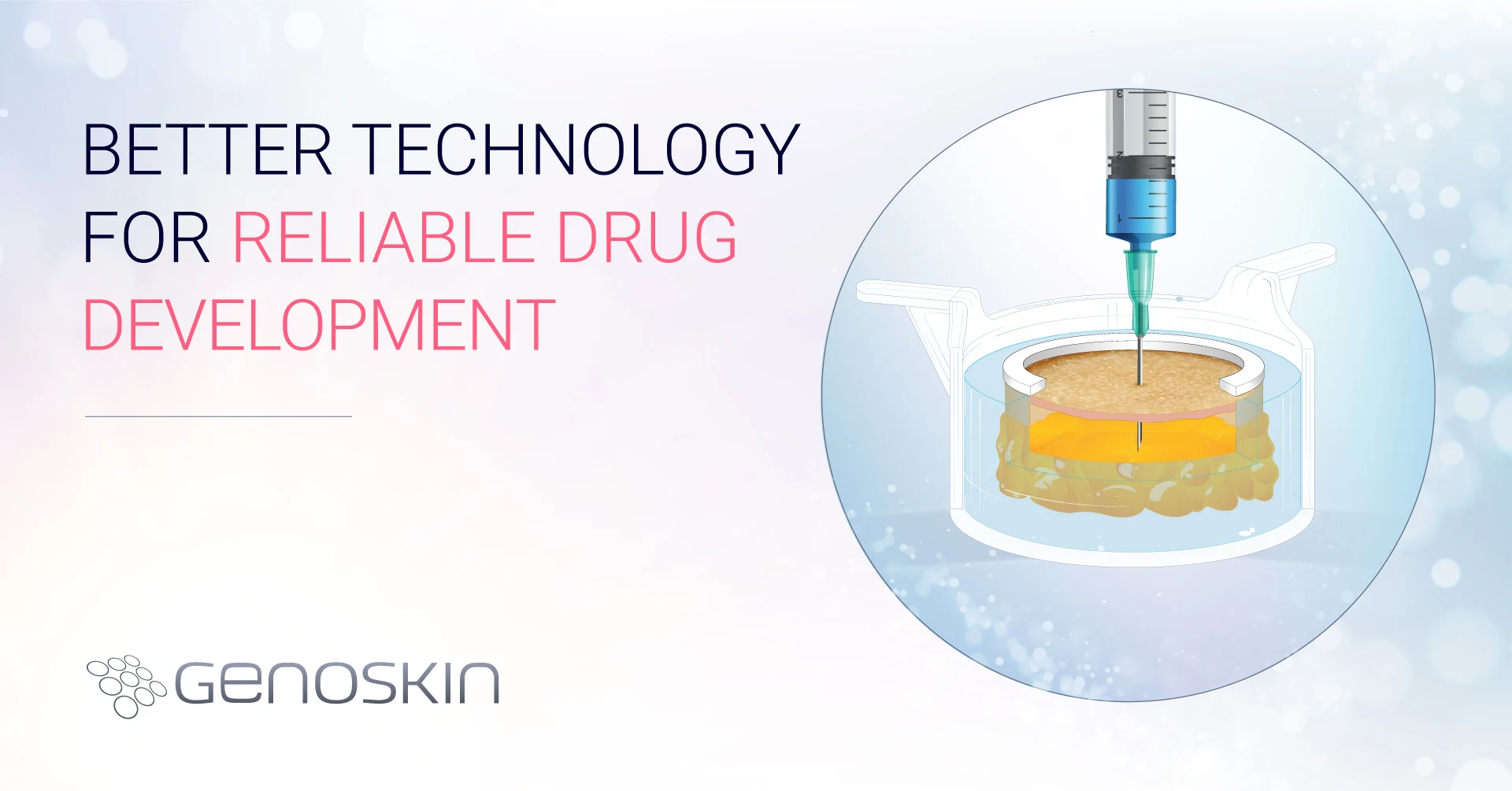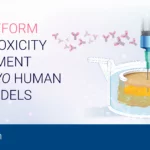Advancing New Approach Methodologies for ethical & reliable drug development
New Approach Methodologies: Changing drug development as we know it
Drug development is long, expensive, and painfully inefficient. With 90% of drug candidates failing before clinical approval, the industry is desperate for human-relevant, predictive tools—this is where New Approach Methodologies (NAMs) have emerged as a vital solution. At Genoskin, we combine live ex vivo human skin models with advanced analytics to create NAM-based solutions that provide reliable human data earlier in the drug development pipeline. Our goal? Reduce failure rate, save years of development time, and cut unnecessary animal testing – while supporting pharmaceutical, biotech, and cosmetic industries.
The need for New Approach Methodologies in drug development
9 out of 10 drug development projects will fail
The path to bringing new drugs to market is becoming slower, costlier, and less efficient. Despite decades of investments towards innovation, 9 out of 10 investigational drugs still fail to reach approval. The overall success rate from Phase I clinical trials to FDA approval remains around 10%, a number that has stubbornly resisted change.
Making matters worse, the cost of failure is skyrocketing. Recently, the average cost to bring a single drug to market has ballooned to over $2.6 billion, driven by high attrition rates and late-stage clinical trial failures. These numbers highlight an uncomfortable truth: our current preclinical models aren’t predictive enough.
To overcome this challenge, the industry is turning to New Approach Methodologies (NAMs)—a growing set of non-animal, human-relevant tools and technologies aimed at improving decision-making earlier in the pipeline. Regulatory agencies such as the EMA, and FDA are also actively encouraging this shift, recognizing the limitations of traditional animal models.
While the industry still needs to pivot further toward the routine use of NAMs, the methodologies themselves must also continue to evolve—to become more predictive, more standardized, and more integrated into regulatory processes—to truly reduce reliance on animal testing and accelerate the development of safer, more effective therapies.
The limit of animal models in predicting human response
For decades, animal models have been the default approach for evaluating drug safety and efficacy before clinical trials. Their use is deeply embedded in regulatory frameworks—especially since the 1938 U.S. Food, Drug & Cosmetic Act, which made animal testing a requirement for new drugs seeking FDA approval. But the biological gap between animals and humans is hard to ignore. Even well-established animal models often fail to predict human-specific toxicity, immunogenicity, or efficacy. Species differences in immune systems, metabolism, and drug absorption mean that promising results in animals frequently fail to translate into success in humans.
This disconnect contributes significantly to late-stage clinical trial failures, wasted resources, and safety risks. More importantly, it raises a fundamental question: Why rely on models that don’t represent the human condition when better options are emerging?
Today, a growing body of evidence supports the use of human-relevant alternatives—NAMs that better mimic human biology and can provide earlier, more predictive insights into how a compound will behave in patients.
A regulatory shift: The FDA Modernisation Act of 2021 and global momentum
Change is underway on the regulatory front. In the United States, the FDA Modernization Act of 2021 marked a significant milestone by proposing to remove the mandatory requirement for animal testing before initiating human clinical trials. The Act opened the door to the use of non-animal, science-driven alternatives, including cell-based assays, organ-on-a-chip systems, in silico computational models, and other human biology-based methods—such as Genoskin’s live ex vivo human skin models.
This initiative reflects a broader international momentum. Regulatory agencies like the EMA, OECD, and MHRA are actively exploring frameworks to encourage the adoption of New Approach Methodologies (NAMs), acknowledging their potential to deliver more predictive, ethical, and efficient safety assessments.
Still, legislative change is only part of the equation. For NAMs to gain widespread acceptance, they must continue to prove their scientific robustness, reproducibility, and regulatory relevance—and be positioned not as replacements for animal models, but as complementary tools to answer specific human questions that traditional models cannot.
From surgical waste to scientific insight: Advancing NAMs with real human skin
Sourcing real human tissue: From surgical waste to predictive science
Each year, hundreds of thousands of human skin samples—typically discarded after routine plastic surgery procedures— go unused, despite their enormous potential to inform drug development. At Genoskin, we turn these otherwise wasted surgical leftovers into powerful tools to evaluate drug effects in a real human context.
Our approach stands apart from traditional biobanking. Although cryopreserved human skin is commonly used in research, the process compromises tissue viability and cellular integrity, restricting the scope of usable data. As a result, these models often fall short when it comes to accurately mimicking the complexity of live human skin responses.
Preserving viability: A step beyond biobanking and artificial Models
To overcome these limitations, Genoskin developed a proprietary biostabilization technology that preserves the viability, structure, and immune competence of the human skin components for up to 7 days ex vivo. This innovation enables researchers to conduct longitudinal studies on real, immunocompetent human tissue—without the ethical and logistical burdens of clinical sampling.
Unlike artificial skin substitutes, reconstructed models, or bioprinted tissues, Genoskin’s native human skin platforms contain the full cellular and structural complexity of skin—keratinocytes, fibroblasts, immune cells, nerve endings, vasculature remnants, and skin appendages—all working together to produce more physiologically relevant data.
By combining real human tissue with controlled, reproducible conditions, this model fills a critical gap in the NAMs ecosystem—allowing drug developers to move beyond prediction based on proxy models, and toward direct insights on human biology. These models are available in multiple formats—healthy skin, inflamed or psoriatic skin, wounded skin, and injectable skin—each tailored to specific research and development needs. When paired with downstream assays such as transcriptomics, multiplexed protein analysis, or spatial imaging, Genoskin’s ISO9001 certified platforms enable deep mechanistic understanding of immune responses, local toxicity, and therapeutic impact in real human tissue.
Combining human diversity with advanced analytics for predictive insights
Drug safety and efficacy are influenced by variables such as age, sex, phototype, and immune status—yet most preclinical models ignore this diversity. At Genoskin, we embrace it. Each of our skin models is derived from a consented human donor, allowing researchers to account for inter-individual variability that better reflects clinical reality.
By combining this donor-specific biological input with high-content analytics, we create a framework to simulate early-stage clinical trials outside the human body.
This approach provides:
- Mechanistic insights into local immune activation, injection site reactions, or tissue remodeling
- Data to support comparative studies across donor
- Human-relevant evidence to de-risk compounds earlier in development
It’s a practical, ethical, and scalable alternative to exploratory animal studies. While NAMs still require broader adoption and regulatory integration, platforms like Genoskin’s show how combining real human biology with robust analytical assays can drive better decisions—earlier and more confidently.
Conclusion: Toward a more human-relevant future in drug development
As drug developers and regulators shift toward NAMs, the need for predictive, ethical, and scalable human-relevant models has never been greater. At Genoskin, we’ve built a platform that transforms discarded surgical tissue into highly functional testing systems—capable of mimicking early-stage clinical trials across diverse donor profiles, without using animals or exposing human volunteers to risk.
By combining live, immunocompetent skin with advanced analytics, our approach supports smarter decisions in the lab—and ultimately, safer and more effective therapies for patients.
NAMs are not just the future—they are already reshaping the present. To fully realize their potential, we must continue investing in tools that are not only more ethical, but also scientifically superior.
Comments are closed.






